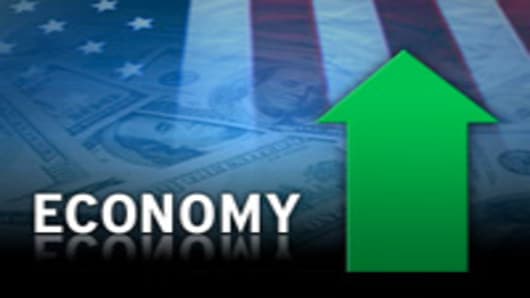The U.S. economy grew at a revised 0.9 percent annual rate in the first quarter, slightly better than previously thought because of lower demand for foreign goods and services and a pickup in non-residential building, the Commerce Department said Thursday.
The department estimated a month ago that gross domestic product, which measures the total output of goods and services within U.S. borders, grew at a 0.6 percent rate. But it raised the growth estimate to take into account updated economic and trade data.
Growth in the January-March quarter was in line with economists' expectations. The economy grew at a 0.6 percent rate in the fourth quarter of 2007.
"The underlying domestic demand in the economy showed slight improvement. It's probably consistent with the Fed being on hold in June and several months after that, and consistent with euro trading in the broad range it's been in against the dollar," said Nick Bennenbroek, currency strategist with Wells Fargo in New York.
The upward revision to first-quarter growth and the inflation readings in the quarter is likely to provide some comfort to the Federal Reserve, which has become increasingly concerned about rising prices amid slowing growth and has signaled that it may pause a string of interest rate cuts.
The Labor Department reported that claims for new jobless benefits rose slightly more than expected last week, while the tally of those still drawing benefits hit its highest mark in more than four years. Initial claims for state unemployment insurance benefits rose to 372,000 last week from an upwardly revised 368,000 for the prior week.
Inflation data in the GDP report was mixed. The personal consumption expenditures price index for the quarter rose at a 3.5 percent annual rate, the same as the previous estimate. But the core PCE price index, which is closely watched by the Federal Reserve and excludes volatile food and energy costs, was revised lower to 2.1 percent from 2.2 percent.
Market reaction to the data was mixed, with U.S. Treasury debt prices paring losses and the dollar steady at higher levels against the euro and yen. U.S. stock index futures slipped.
Consumer spending, which accounts for more than two-thirds of national economic activity, was left unrevised at a 1 percent increase for the first quarter. But within that category, spending on non-durable goods fell 0.3 percent, compared with a 1.3 percent decline in the previous estimate.
This helped make up for a downward revision in consumer spending on durable goods to a fall of 6.2 percent from an initially estimated fall of 6.1 percent.
Imports, Exports Lower
The Commerce Department said imports of goods and services fell 2.6 percent in the first quarter, a sharp revision from the 2.5 percent increase initially estimated. But exports, a recent source of strength for the U.S. economy, also were weaker than first thought, with the first-quarter figure revised to an increase of 2.8 percent from a 5.5 percent rise.
Investment in nonresidential structures rose 1.1 percent compared with a 6.2 percent fall estimated last month. This was partially offset by a $14.4 billion drop in private inventories, previously estimated as a $1.8 billion rise.
Residential investment also was revised to a 25.5 percent decline from a 26.7 percent decline previously. This was still the steepest drop since the fourth quarter of 1981, when it fell 35.1 percent.
The department said businesses decreased inventories in the quarter, a shift from the prior estimate in which it had said stocks had risen. The slimmer level of inventories bodes well for production going forward.
In its first estimate of corporate profits for the quarter, the Commerce Department said after-tax corporate profits rose 3.8 percent after falling 3.3 percent in the fourth quarter.


